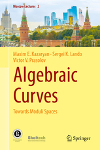- About MAA
- Membership
- MAA Publications
- Periodicals
- Blogs
- MAA Book Series
- MAA Press (an imprint of the AMS)
- MAA Notes
- MAA Reviews
- Mathematical Communication
- Information for Libraries
- Author Resources
- Advertise with MAA
- Meetings
- Competitions
- Programs
- Communities
- MAA Sections
- SIGMAA
- MAA Connect
- Students
- MAA Awards
- Awards Booklets
- Writing Awards
- Teaching Awards
- Service Awards
- Research Awards
- Lecture Awards
- Putnam Competition Individual and Team Winners
- D. E. Shaw Group AMC 8 Awards & Certificates
- Maryam Mirzakhani AMC 10 A Awards & Certificates
- Two Sigma AMC 10 B Awards & Certificates
- Jane Street AMC 12 A Awards & Certificates
- Akamai AMC 12 B Awards & Certificates
- High School Teachers
- News
You are here
Algebraic Curves, Towards Moduli Spaces

Publisher:
Springer
Publication Date:
2019
Format:
Hardcover
Edition:
1
Series:
Moscow Lectures
Price:
74.99
ISBN:
9783030029425
Category:
Textbook
[Reviewed by , on ]
Felipe Zaldivar
04/22/2019
The foundations of the theory of complex algebraic curves were laid out by Riemann and Abel in the 19th century with the aim of globally solving and understanding several important problems of complex analysis, ranging from the multivaluedness of certain integrals to the analytic continuation of functions and the theory of singularities. The foundations developed by Riemann included the introduction of the first notions and results of the topology of manifolds. This would later become an important subject on its own. By the end of the 19th century Dedekind and Weber would bring the powerful algebraic methods that were being developed at that time to bear, showing the deep connections between the arithmetic of number fields and the geometry of algebraic curves.
There are many excellent books devoted to some aspects of the theory of algebraic curves, with various approaches and emphases depending not only on the taste of the authors but also on the multifaceted nature of these objects: complex analytic, topological or algebro-geometrical. There is, however, a subtle point that shows that the history of the subject also influences the approach taken by the different authors: for most of the last century the research on algebraic curves was focused on individual curves. During the last four decades of the 20th century the focus of research on algebraic curves moved from individual curves to families of curves, somehow retaking a theme already considered by Riemann in one of his foundational papers, the moduli space of complex algebraic curves of a given genus. However, a proper definition of a moduli space required a large part of the algebraic geometry developed in the second half of the last century.
The book under review is an accessible introduction to the study of complex algebraic curves and their moduli spaces. Here the word accessible is important since the authors try to keep the sophistication of modern algebraic geometry to a minimum. Thus, the aim is for a middle ground between elementary approaches devoted to the study of individual curves and advanced monographs that use modern algebraic geometry methods to study various moduli problems. The first twelve chapters give a concise but detailed introduction to the study of individual complex algebraic curves up to the Riemann-Roch and Abel-Jacobi theorems. The last six chapters provide an introduction to the construction and properties of moduli spaces of complex algebraic curves. Among the remarkable characteristics of the authors' approach are the many examples that enrich these chapters: The moduli space of curves of a given genus and some marked points, emphasizing first the case of rational curves and the elliptic example. Motivations of the requirements for a moduli space and their various compactifications. Stable curves and the moduli spaces of stable maps. There is always an explicit example or calculation grounding the subject and giving a feeling of accessibility to the reader.
In light of their connections to many subjects within mathematics and outside of it, complex algebraic curves and their moduli spaces continue to attract our interest. The book under review is well suited as an introduction to these subjects. The book comes with sets of exercises in each of its chapters and can be used as a textbook for a graduate course or for self-study by a motivated reader.
Felipe Zaldivar is Professor of Mathematics at the Universidad Autonoma Metropolitana-I, in Mexico City. His e-mail address is fz@xanum.uam.mx
See the publisher's page.
- Log in to post comments




